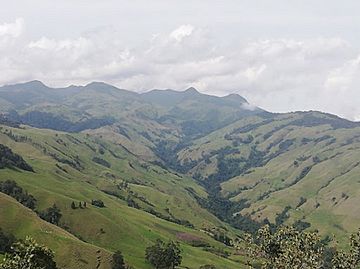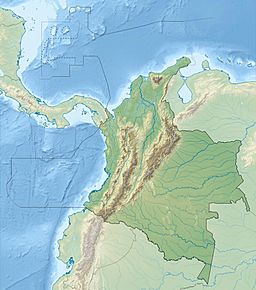Romeral (volcano) facts for kids
Quick facts for kids Romeral |
|
|---|---|
| Volcán Romeral | |

Romeral
|
|
| Highest point | |
| Elevation | 3,858 m (12,657 ft) |
| Listing | Volcanoes of Colombia |
| Geography | |
| Location | Caldas |
| Parent range | Central Ranges, Andes |
| Geology | |
| Age of rock | Pliocene-Holocene |
| Mountain type | Andesitic-dacitic stratovolcano |
| Last eruption | 5390 BCE ± 500 years |
Romeral is a large stratovolcano located in the Caldas region of Colombia. It is the most northern volcano in South America that has been active in the last 11,700 years. This period is known as the Holocene epoch. Romeral is part of a chain of volcanoes called the Andean Volcanic Belt.
Contents
Discovering Romeral Volcano
Romeral is a type of volcano known as a stratovolcano. This means it has a tall, cone-like shape. It was formed a very long time ago, about 3 million years ago, during a period called the Pliocene epoch. The volcano is made up of volcanic rocks like andesite and dacite.
What is a Stratovolcano?
A stratovolcano is also known as a composite volcano. It is built up over many eruptions. These eruptions lay down layers of hardened lava, ash, and rock fragments. This process creates the volcano's classic cone shape. Stratovolcanoes can have powerful and explosive eruptions.
Where is Romeral Located?
Romeral is found in the Central Ranges of the Andes mountains. The Andes are the longest mountain range in the world. Romeral is part of the Andean Volcanic Belt, which stretches along the western edge of South America. This belt is divided into several zones. Romeral is in the North Volcanic Zone.
When Did Romeral Last Erupt?
The last known eruption of Romeral happened around 5390 BCE. This was about 7,400 years ago. While this sounds like a very long time, in geological terms, it means the volcano is still considered relatively young and potentially active.
See also
- List of volcanoes in Colombia
- List of volcanoes by elevation
 In Spanish: Volcán Romeral para niños
In Spanish: Volcán Romeral para niños


